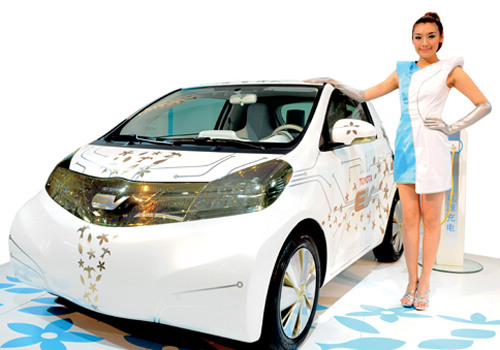|
 |
|
EV CONCEPT VEHICLE: The FT-EV electric concept vehicle is on show at the 7th China Changchun International Automobile Fair. New-energy vehicles, such as pure-electric vehicles and hybrid vehicles, have become a main part of the exhibition (JIANG LIN) |
The Chinese Government has set a target of having 500,000 all-electric and plug-in vehicles on the road by 2015. However, technological stumbling blocks such as insufficient infrastructure must be tackled to clear the way for the sector's development. A more successful business model is also badly needed for the fledgling sector.
The State Council, or China's cabinet, adopted a development plan for energy-saving and new-energy vehicles (2012-20) on April 18 at its executive meeting, promising that pure electric vehicles will be the main strategic orientation for transforming China's auto industry.
"Prioritizing purely electricity-driven vehicles will be the major strategic route for China to transform the auto industry. And the current focus is to promote the industrialization of pure electric cars and plug-in hybrid electric vehicles," said Premier Wen Jiabao at the meeting.
Plug-in hybrid electric vehicles utilize rechargeable batteries that can be restored to full charge by connecting a plug to an external electric power source.
According to the plan, China's accumulative output of pure electric and plug-in hybrid electric vehicles will rise to 500,000 units by 2015 and 5 million units by 2020. The country will try to lower average fuel consumption of automobiles produced in 2015 to 0.069 liters per km and those produced in 2020 will see their average consumption drop to 0.05 liters per km. The plan also underscored the necessity of requiring domestic manufacturers to become capable of independently producing state-of-the-art components for new-energy cars.
In a bid to accomplish the above-mentioned goals, the Chinese Government has geared up a series of incentives, including implementing innovation projects, expanding the pilot program for subsidizing private ownership of new-energy cars, building more charging stations, creating more facilities for recycling batteries, improving the unified standard system, enhancing fiscal support and actively introducing international cooperation in the field.
In the first quarter of this year, China sold more than 10,000 energy-saving and new-energy vehicles, among which 1,830 were pure-electric vehicles, 1,499 were hybrid vehicles and 6,873 were alternative fuel vehicles, according to data from the China Association of Automobile Manufacturers (CAAM).
It is the first time that the CAAM has taken the production and sales of new-energy vehicles into its statistics as more consumers consider purchasing them.
China kicked off the promotion for energy-saving and new-energy vehicles five years ago.
And in 2009 China started a demo project in 10 cities, requiring each to incorporate 1,000 new-energy vehicles into its municipal fleets.
In late 2010, the list was expanded to cover a total of 25 cities, including Beijing and Shanghai. Right now, most sales of energy-saving and new-energy vehicles have occurred in these cities.
Since June 2010, China has launched trial subsidy programs in five cities—Shanghai, Changchun, Shenzhen, Hangzhou and Hefei—with the amount of subsidies to a purely electric vehicle and a hybrid vehicle hitting 60,000 yuan ($9,516) and 50,000 yuan ($7,930), respectively.
The released plan reassured the Chinese Government's resolution to spur the purchase of energy-saving vehicles by expanding the pilot program for subsidizing the private ownership of new-energy cars. This means more generous incentive policies may come out in the future and private purchase will be the main part for government subsidy.
| 